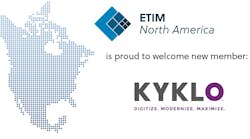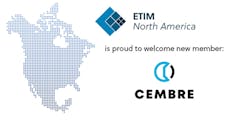Buying, replacing, or upgrading your enterprise software (the software you need to run your business) can easily overwhelm even the savviest electrical distributor. Yet, by following a few simple steps, your software-purchasing experience can be as profitable for you as the end result is for your business.
The average life expectancy of enterprise software is four to seven years. Even if you're happy with the software you're using to manage your inventory and orders, track your accounts payable and receivable, and do everything else between, if it's more than four years old, it's likely to be outdated. Here are a few tips to help you go about the process.
Step 1 — Recruit the team
The first, and perhaps most critical, step in searching for enterprise software is putting together a good team. When looking at enterprise software, many distributors make the mistake of leaving the decision solely to their information technology (IT) staff. In reality, purchasing software is a pure business decision. Unless the IT team understands the vision of the company for the next four to seven years, they cannot judge the value a software solution will bring to the business. Ideally, the team selecting your new enterprise-software solution should include a high-level executive with long-range vision, line managers from each discipline to ensure proper functionality and IT staff to review the systems and technology on a technical basis.
Step 2 — Develop the plan
The team should develop a list of priorities for what the new software must accomplish. The list doesn't need to be a 200-page document with 10,000 requirements. A checklist to keep the team focused on solving problems important to your company will do the job. As software vendors bring up issues you did not consider, measure them against your vision to determine their importance to your company.
Once you understand your key issues, make a short list of software suppliers. A quick way to do that is to search the Internet or scan the advertisements in industry trade publications. Search the Internet by going to a search engine and typing “distribution software” into the search box. This will give you a list of software companies that focus on distribution. Visit each company's Web site to find out if they cover your basic needs and request literature. You may end up with five to ten software companies to explore further.
Call or e-mail each vendor on your list and ask a few simple questions. Be sure to let the vendor know up front that the answers to these questions will go on any contract you sign with them if you choose them as the provider of your enterprise-software solution. This will ensure accurate answers. Some questions you may want to ask:
-
How long has the company been in business? Longevity in a technology provider can indicate whether the company will be around in the future to support your business.
-
What percentage of the customer base are distributors? What is the exact number? Distribution is very different from other businesses. You don't want to have to teach a software vendor how the electrical distribution industry works.
-
What percent of the budget has been invested in research and development (R&D)? How much was spent on R&D in each of the last three years? If the vendor is not investing in their future, then there will be no future for you.
-
When was the most recent product released? How many customers are using it? Stress your interest in knowing about their newest product and not a modification to a product that has been out for a while. You do not want to invest in an old product, but you do not want to be a guinea pig for a new product. There must be balance.
-
What makes you unique compared to your competitors? Find out what their vision of the industry is.
Once you have the answers to the above questions, you should be able to identify two or three vendors to start evaluating.
Step 3 — Evaluate the options
Now that you've narrowed your list, all you have to do is schedule a bunch of demonstrations and make a decision, right? Unfortunately, it's not that easy. There are several steps to ensure you find the enterprise-software solution that best fits your needs. Before beginning the evaluation process, develop a time frame and stick to it. Otherwise, you could suffer from paralysis from analysis and never make a decision.
Your team should meet with each vendor and provide a full vision of company goals with regard to a software solution. Rate each vendor on several key areas, including: product functionality, technology infrastructure, implementation process, long-term support, their vision for the future from both a technology and industry standpoint, and their long-range financial viability. While each area is important, some may carry more weight than others depending upon your needs. In addition, the software vendor should make valuable contributions to the conversation and demonstrate a firm knowledge of the electrical industry.
While you're interviewing vendors, request a copy of the contract you will be expected to sign should you choose their solution. Many of these contracts favor the software vendor; have a lawyer who understands intellectual property contracts (software purchases) review them. Make sure there are no major legal roadblocks before you invest too much time with a particular software vendor.
After you've interviewed the vendors and reviewed their contracts with your lawyer, invite the vendors to your site to give product demonstrations. Allow the vendor to drive the demonstration. Don't push them in different directions, but do make sure all the critical issues that you went over in the interview process are covered.
If you're satisfied with what you've seen in the demonstration, phone the vendors' references and talk with long-term users of the system you're interested in. Since you will not find one company exactly like yours, it is important to talk to many references. Ask very specific questions that focus on your critical issues. Most likely you will have to talk to many people to find answers to all your questions. Don't forget to ask about implementation and training, ongoing support, custom software, and the overall attitude of the vendor's staff. All these things are as important as the software itself. The most important question to ask: If you could do it all over again, what would you do differently?
Step 4 — Request proposals and take a road trip
At this point, it's time to request a proposal. As tempting as it is to request one sooner, you want to wait until the vendors know you and your needs to ensure every module and option critical for your business is included. As you compare the proposals, look at the value each vendor provides. Focusing only on price could result in disaster. While the price might have the most impact on your bottom line over the short-term, having adequate support, enhanced functionality, and opportunities to grow your solution as your business grows will have the greatest long-term impact.
Once you've reviewed the proposals and selected the vendor that best meets your needs, take some time and visit at least two of that vendor's customers. Rather than selecting businesses like yours, visit ones that represent what you aspire to be in a few years. Remember, you are not just buying software for today; it is for the future as well. Bring a list of critical questions and try to meet with users as well as technical and executive staff. Respect the time they need to run their business, but make sure you get all your questions answered.
Seeing the software solution in a live setting should confirm your decision to work with a particular vendor. If it doesn't or new issues arise, give the vendor one chance to address the problem before scheduling site visits with the next vendor on your list.
Step 5 — Close the deal
When you are fully satisfied, it's time to start negotiating with the vendor. Up until this point, you and the vendor have been testing your compatibility. Now you are about to enter into a long-term partnership. If you focus on the relationship and make it a win-win situation, both you and the vendor will have a much better experience. Of course you want to get the best price possible, but at the same time you need to realize that this is a long-term commitment. Ultimately, extra services or extended agreements may better serve your needs.
Don't leave the vendor feeling raked over the coals — it may be held against you in the future. At the same time, leaving money on the table signals the vendor that he can always overcharge you. Negotiate hard but fair to ensure you will get the greatest return on your investment.
If done correctly, the work put into selecting a new enterprise software solution will pay huge dividends by giving your company a solution that increases sales, improves customer service and reduces operating costs.
Doug Levin, executive vice president for Prophet 21 Inc., Yardley, Pa., is widely recognized as an expert in technology for distributors.








